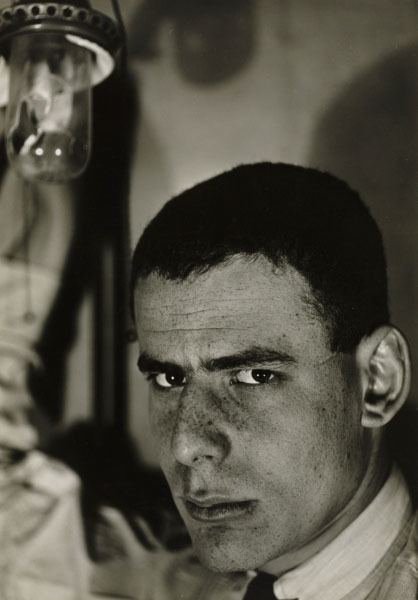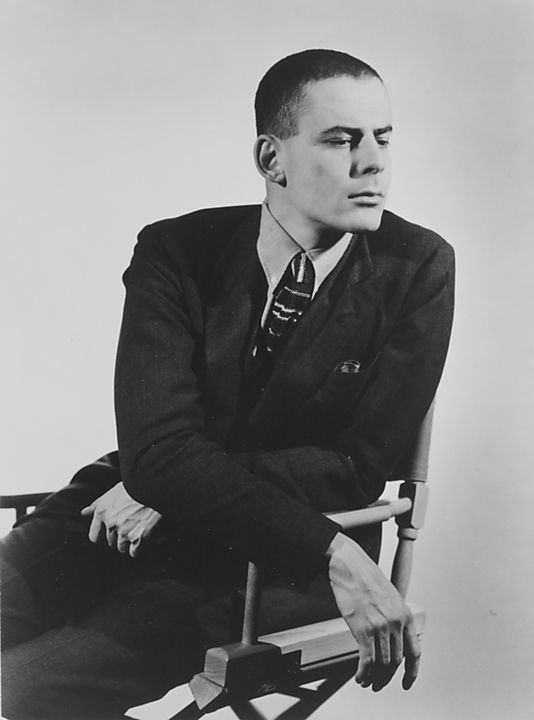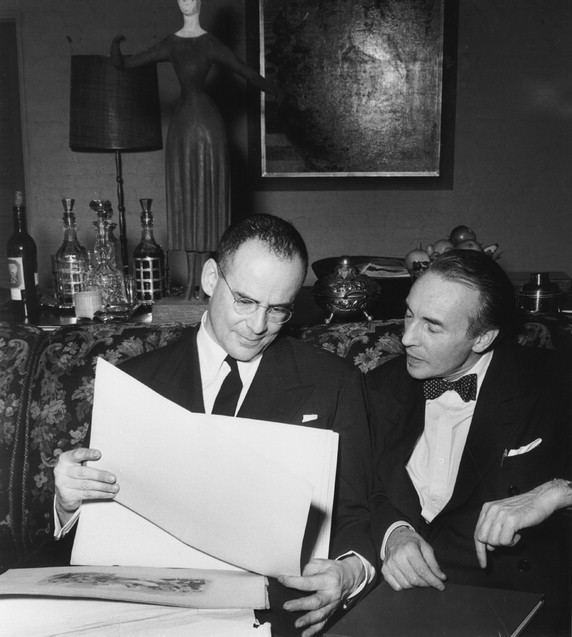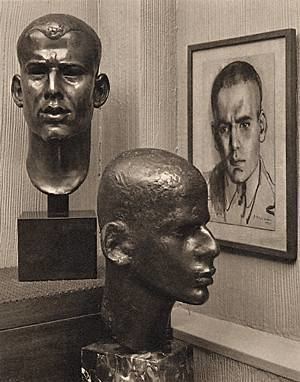Name Lincoln Kirstein Years of service 1943–1945 Role Writer | Rank Private First Class Movies Glory | |
 | ||
Born May 4, 1907Rochester, New York, U.S. ( 1907-05-04 ) Spouse Fidelma Cadmus (m. 1941–1991) Books Lay This Laurel; An Album on, Movement & metaphor, Dance - a short history of, The Classic Ballet: Ba, Mosaic Memoirs Similar People Robert Gould Shaw, Kevin Jarre, Edward Zwick, Richard Benson, Denzel Washington | ||
Hlpc cultural medallion lincoln kirstein december 12 2013
Lincoln Edward Kirstein (May 4, 1907 – January 5, 1996) was an American writer, impresario, art connoisseur, philanthropist, and cultural figure in New York City, noted especially as co-founder of the New York City Ballet. He developed and sustained the company with his organizing ability and fundraising for more than four decades, serving as the company's General Director from 1946 to 1989. According to the New York Times, he was "an expert in many fields," organizing art exhibits and lecture tours in the same years.
Contents
- Hlpc cultural medallion lincoln kirstein december 12 2013
- Glory 8 8 movie clip breaching fort wagner 1989 hd
- Early life
- Early career
- World War II and Monuments Men
- Ballet
- Personal life
- Legacy
- Honors
- Broadway credits
- References

Glory 8 8 movie clip breaching fort wagner 1989 hd
Early life

Kirstein was born in Rochester, New York to Jewish parents, the son of Rose Stein (1873–1952) and Louis E. Kirstein (1867–1942). His sister was Mina Kirstein and his paternal grandparents were Jeanette (née Leiter) and Edward Kirstein, a successful Rochester clothing manufacturer who ran E. Kirstein and Sons, Company. He grew up in a wealthy Jewish Bostonian family and attended the private Berkshire School, along with George Platt Lynes, graduating in 1926. He then attended Harvard, where his father, the vice-president of Filene's Department Store, had also attended, graduating in 1930. His maternal grandfather was Nathan Stein, a senior executive at the Stein-Bloch & Co., in Rochester.
Early career

In 1927, while still an undergraduate at Harvard, Kirstein was annoyed that the literary magazine The Harvard Advocate would not accept his work. With a friend Varian Fry, who met his wife Eileen through Lincoln's sister Mina, he convinced his father to finance their own literary quarterly, the Hound & Horn. After graduation, he moved to New York in 1930, taking the quarterly with him. The publication gained prominence in the artistic world and ran until 1934 when Lincoln instead decided to fund the Russian choreographer George Balanchine in his development of an American ballet school and company.

His interest in ballet and Balanchine started when he saw Balanchine's Apollo performed by the Ballets Russes. Kirstein became determined to bring Balanchine to America. In October 1933, together with Edward Warburg, a classmate from Harvard, and Vladimir Dimitriew, Balanchine's manager, they started the School of American Ballet in Hartford, Connecticut. In 1934, the studio moved to the fourth floor of a building at Madison Avenue and 59th Street in New York City. Warburg's father, Felix M. Warburg, invited the group of students from the evening class to perform at a private party. The ballet they performed was Serenade, the first major ballet choreographed by Balanchine in the United States. Just months later Kirstein and Warburg founded, together with Balanchine and Dimitriew, the American Ballet which became the resident company of the Metropolitan Opera. That arrangement was unsatisfactory because the Opera would not allow Balanchine and Kirstein artistic freedom.
World War II and Monuments Men

Kirstein's theatrical career was interrupted by the United States' entry into World War II. After enlisting in 1943, before going overseas he started working on a project gathering and documenting soldier art. He eventually developed this as the exhibit and book Artists Under Fire. In the spring of 1944, Kirstein traveled to London for the U. S. Arts and Monuments Commission and after a month, was transferred to the unit in France that came to be known as the Monuments, Fine Arts, and Archives (MFAA). The section was devoted to rescuing and preserving European art. Soon after in January 1945, Kirstein was promoted to Private First Class in Patton's Third Army and his unit moved to Germany. Kirstein was personally involved with retrieving artworks around Munich and from the salt mines at Altaussee. His article "The Quest for the Golden Lamb" about the quest was published in Town & Country in September 1945, the same month he was discharged from the Army.
Ballet

In 1946, Balanchine and Kirstein founded the Ballet Society, which was renamed the New York City Ballet in 1948. In a letter that year, Kirstein stated, "The only justification I have is to enable Balanchine to do exactly what he wants to do in the way he wants to do it." Kirstein went on to serve as the company's General Director from 1946 until 1989.

In a 1959 monograph titled What Ballet Is All About, Kirstein wrote: "Our Western ballet is a clear if complex blending of human anatomy, solid geometry and acrobatics offered as a symbolic demonstration of manners—the morality of consideration for one human being moving in time with another."
In a conversation with the poet Vernon Scannell in 1976, he said that "he regarded dancers not as artists but as acrobats'; their skills were, he maintained, entirely physical and he felt his involvement with the dance was a salutary escape from the cerebral and sedentary life into a world that was closer to that of the athlete than the artist." Kirstein's and Balanchine's collaboration lasted until the latter's death in 1983.
Personal life
Beginning in 1919, Kirstein kept a diary continuing through the practice until the late 1930s. In a 2007 biography of Kirstein, The Worlds of Lincoln Kirstein, Martin Duberman drew on his diaries, as well as Kirstein's numerous letters. Kirstein wrote about enjoying sex with various men including Harvard undergraduates, sailors, street boys, and casual encounters in the showers at the 63rd St. YMCA. He had longer affairs with Pete Martinez, a dancer, Dan Maloney, an artist, and Jensen Yow, a conservator. Kirstein had both platonic relationships and many that started as casual sex and developed into long-term friendships.
Despite his same-sex affairs, he also maintained relationships with women. In 1941, he married Fidelma Cadmus (1906–1991), a painter and the sister of the artist Paul Cadmus. Kirstein and his wife enjoyed an amicable if sometimes stressful relationship until her death in 1991, but she withdrew from painting and then from life, suffering breakdowns that were eventually more permanent than his. Some of his boyfriends lived with them in their East 19th Street house; "Fidelma was enormously fond of most of them." The New York art world considered Kirstein's bisexuality an "open secret," although he did not publicly acknowledge his sexual orientation until 1982.
Kirstein's eclectic interests, ambition and keen interest in high culture, funded by independent means, drew a large circle of creative friends from many fields of the arts. These included: Glenway Wescott, George Platt Lynes, Jared French, Bernard Perlin, Pavel Tchelitchev, Katherine Anne Porter, Barbara Harrison, Gertrude Stein, Donald Windham, Cecil Beaton, Jean Cocteau, W. H. Auden, George Tooker, Margaret French Cresson, Walker Evans, Sergei Eisenstein and others.
In his later years, Kirstein struggled with bipolar disorder – mania, depression, and paranoia. He destroyed the studio of friend Dan Maloney. He sometimes had to be constrained in a straitjacket for weeks at a psychiatric hospital. His illness did not generally affect his professional creativity until the end of his life.
Legacy
English critic Clement Crisp wrote: "He was one of those rare talents who touch the entire artistic life of their time. Ballet, film, literature, theatre, painting, sculpture, photography all occupied his attention."
Kirstein helped organize a 1959 American tour for musicians and dancers from the Japanese Imperial Household Agency. At that time, Japanese Imperial court music, gagaku, had only rarely been performed outside the Imperial Music Pavilion in Tokyo at some of the great Japanese shrines.
Kirstein commissioned and helped to fund the physical home of the New York City Ballet: the New York State Theater building at Lincoln Center, designed in 1964 by architects Philip Johnson and John Burgee. Despite its conservative modernist exterior, the glittery red and gold interior recalls the imaginative and lavish backdrops of the Ballets Russes. He served as the general director of the ballet company from 1948 to 1989.
On March 26, 1984, President Ronald Reagan presented Kirstein with the Presidential Medal of Freedom for his contributions to the arts.
Kirstein was also a serious collector. Soon after the opening at Lincoln Center of the New York Public Library for the Performing Arts, he contributed a significant amount of historic dance materials to the Jerome Robbins Dance Division. Before his death in 1996, Kirstein also donated his personal papers, artworks, and other materials related to the history of dance and his life in the arts to the Division. Kirstein was also the primary patron of Fidelma's brother, the artist Paul Cadmus, buying many of his paintings and subsidizing his living expenses. Cadmus had difficulty selling his work through galleries because of the erotically charged depictions of working and middle class men, which provoked controversy.
